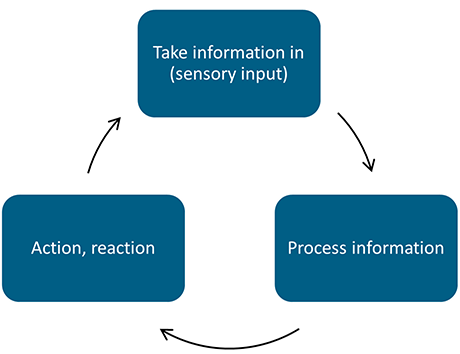How a person takes in, understands, and reacts to sensations (sensory information) coming from inside and outside the body is called sensory processing. The brain needs input from the senses to function. Everybody processes sensory information, adults and children.
Every new sensation is processed and leads to a new action or reaction. It’s a constant loop that happens very fast. We all respond differently because the brain uses our experiences and history to understand sensations. Everyone takes in, processes, and reacts to sensations differently.
Sensory processing has 3 stages.

- First, the brain takes in information (sensory input). This information comes from:
- eyes, ears, mouth, nose, skin, and organs
- muscles and joints
- inner ear
- Next, the brain processes the information.
- identifies the sensation
- interprets or gives meaning: safe or unsafe, like or dislike
- Then, the brain decides what to do with the information.
- physical action, emotional reaction, or both
- action or reaction leads to a new sensation, starting the cycle again.
Your child’s brain uses sensory information to understand the surrounding environment and their body. Processing sensations helps your child take part in activities and interactions.
The senses
The brain gets information from our 8 senses. These senses take in information (sensation) and tell your child’s brain what is happening outside their body (external) and what is happening inside their body (internal). There are 5 external senses and 3 internal senses.
The 5 external senses are sight, sound, smell, taste, and touch.
- Sight is input from the eyes (visual system). Sensation includes light, colours, and movement.
- Hearing is input from the ears (auditory system) about sounds and noises.
- Taste is input from the tongue (gustatory system). Taste sensation includes sweet, salty, sour, bitter, and umami flavours.
- Smell is input from the nose (olfactory system) about different smells.
- Touch is input from the skin (tactile system). This is the biggest sense organ. Tactile input includes light touch, deep pressure, temperature, vibration, or pain.
- Light touch, also known as protective touch, responds to anything that brushes the skin lightly and can include tickling.
- Deep pressure is firmer touch or squeezing. This part of the tactile system lets your child know how soft or hard touch is. Deep pressure touch can be calming and focusing.
- Temperature tells your child’s brain how hot or cold it is.
- Vibration
- Pain
The 3 internal senses give the brain information and feedback about what is happening inside the body. The 3 internal senses are proprioception, vestibular, and interoception.
- Proprioception is input from the joints, muscles, and tendons. It provides information about how the joints and muscles are moving. This sense allows your child to move their body without needing to look at what they’re doing, such as when they walk up the stairs or zip up their jacket.
- Vestibular is input from the inner ear. This gives your child information about balance and knowing where their body is in space. This sense lets your child know how fast or slow they are moving, if they are going up or down, or changing direction.
- Interoception is input from organs in the body. This sense tells your child when they are hungry, need to use the bathroom, are feeling nervous, or excited. It’s also the ability to notice body signals and connect them to emotions to answer the question “How do I feel?”
Everyone has different levels of tolerance for each sensation. Some children notice sensations very quickly, while others need a lot of input to be aware of the sensation.
Challenges with sensory processing
Sensory processing is unique to each person. Most people can manage everyday sensations without disruption to their daily life.
For 1 in 6 people, the way their brain processes sensations upsets and disrupts their daily routines. You may hear this called Sensory Processing Disorder. This isn’t a recognized diagnosis. Challenges with sensory processing are part of other diagnoses related to development, physical health, and mental health. It’s not a standalone diagnosis. Diagnoses commonly associated with sensory processing challenges include stress, medical or psychological trauma,
autism spectrum disorder, or
attention deficit hyperactivity disorder. This is not a complete list.
It's important to know that we all have sensory preferences that don’t disrupt daily routines or affect function. Challenges with sensory processing may make it hard for your child to take part in daily activities, play, connect with others, and learn. Here are some examples of what it might look like when challenges with sensations affect your child’s daily life.
- They’re overwhelmed by bright lights or loud sounds.
- They’re unable to tolerate common scents, like soap, food, or other people.
- It’s a struggle to brush their teeth or hair.
- They tug and pull at their clothes because they’re unable to ignore clothing tags or sock seams.
- They struggle to focus when there are background noises.
- The foods they eat may be very limited or they may have a strong reaction to certain flavours, temperatures, and textures.
- They constantly squeeze or push too hard on others.
- They’re constantly moving.
- They don’t notice or respond to body cues, like hunger or the need to use the toilet.
Where to get help
For more information about how occupational therapy can help, contact:
- Health Link at 811
- Your local pediatric community rehabilitation services
- Your doctor, public health nurse, or other healthcare provider
